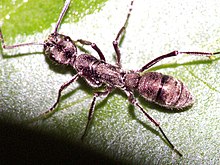
Ponerinae, the ponerine ants, is a subfamily of ants in the Poneromorph subfamilies group, with about 1,600 species in 47 extant genera, including Dinoponera gigantea - one of the world's largest species of ant. Mated workers have replaced the queen as the functional egg-layers in several species of ponerine ants. In such queenless species, the reproductive status of workers can only be determined through ovarian dissections.

Aenictus is a large army ant genus distributed in the Old World tropics and subtropics. It contains about 181 species, making it one of the larger ant genera of the world.

Anochetus is a genus of small, carnivorous ants found in the tropics and subtropics throughout the world.

Centromyrmex is a pantropical, though mainly Afrotropical, genus of ants in the subfamily Ponerinae. This ponerine ant was recorded for the first time in French Guiana and the most northerly point of recording was in Costa Rica. The specimens reported here were collected in a region of Amazon Forest with flight interception traps.

Hypoponera is a genus of ants in the subfamily Ponerinae. The genus has a worldwide distribution and is found in all continents except Antarctica.

Cryptopone is a genus of ants in the subfamily Ponerinae. The genus has a worldwide distribution, with most species occurring in Asia. Workers range from very small to medium in size (1.7–6.1 mm), with the queens being slightly larger.

Platythyrea is a genus of predaceous ants in the subfamily Ponerinae and the sole member of the tribe Platythyreini.

A gamergate is a mated worker ant that can reproduce sexually, i.e., lay fertilized eggs that will develop as females. In the vast majority of ant species, workers are sterile and gamergates are restricted to taxa where the workers have a functional sperm reservoir ('spermatheca'). In some species, gamergates reproduce in addition to winged queens, while in other species the queen caste has been completely replaced by gamergates. In gamergate species, all workers in a colony have similar reproductive potentials, but as a result of physical interactions, a dominance hierarchy is formed and only one or a few top-ranking workers can mate and produce eggs. Subsequently, however, aggression is no longer needed as gamergates secrete chemical signals that inform the other workers of their reproductive status in the colony.

Odontoponera is a small Southeast Asia genus of ants in the subfamily Ponerinae.

Bothroponera is a genus of ants in the subfamily Ponerinae. It is distributed in Africa and Asia.

Brachyponera is a genus of ants in the subfamily Ponerinae.

Rasopone is genus of ants in the subfamily Ponerinae. The genus is restricted to Central and South America.

Ectomomyrmex is a ponerine genus of ants found in Asia and Australia. Little is known about their biology, but they seem to be generalist predators of arthropod prey.

Mesoponera is an Old World genus of ants in the subfamily Ponerinae. It is found in the tropics, from Sub-Saharan Africa to Australia.

Neoponera is a genus of ants in the subfamily Ponerinae. Restricted to the Neotropics, the genus is found from southern Texas to southern Brazil. Workers are slender, and medium to large in size (6.5–19 mm); queens are similar to workers but larger and winged.
Ophthalmopone is a ponerine genus of ants found in Sub-Saharan Africa. Workers are slender and large in size (8–13.5 mm). Queens seem to be absent, but gamergates present.

Pseudoneoponera is a ponerine genus of ants found from India to Australia, they are mostly non queen species, most of the species within the genus thrives on only gamergates.

Diacamma rugosum, also known as the Bornean queenless ant or Asian bullet ant, is a species of ant of the subfamily Ponerinae. It is found in many countries throughout Southeast Asia. 20 subspecies are recognized.

















